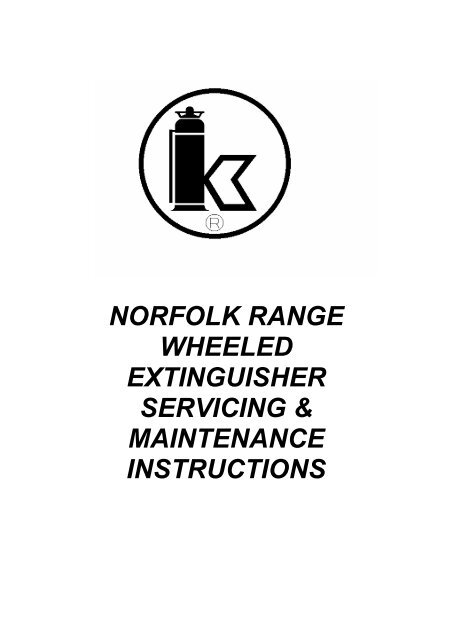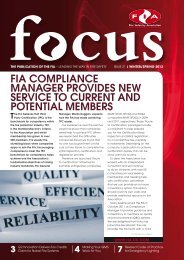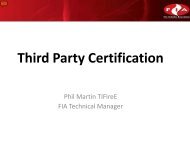NORFOLK RANGE WHEELED EXTINGUISHER SERVICING ... - FIA
NORFOLK RANGE WHEELED EXTINGUISHER SERVICING ... - FIA
NORFOLK RANGE WHEELED EXTINGUISHER SERVICING ... - FIA
Create successful ePaper yourself
Turn your PDF publications into a flip-book with our unique Google optimized e-Paper software.
<strong>NORFOLK</strong> <strong>RANGE</strong><br />
<strong>WHEELED</strong><br />
<strong>EXTINGUISHER</strong><br />
<strong>SERVICING</strong> &<br />
MAINTENANCE<br />
INSTRUCTIONS
SPINTRO REV 3: February 2002<br />
PROCEDURES FOR <strong>SERVICING</strong> THE BRITANNIA <strong>RANGE</strong> OF HAND PORTABLE<br />
FIRE <strong>EXTINGUISHER</strong>S AND THE <strong>NORFOLK</strong> <strong>RANGE</strong> OF <strong>WHEELED</strong> FIRE<br />
<strong>EXTINGUISHER</strong>S<br />
Introduction<br />
The servicing of fire fighting equipment must be carried out by a competent person using<br />
the correct tools to follow the applicable procedures of BS 5306, part 3, 2000 and the<br />
manufacturers instructions.<br />
This maintenance should be performed at least annually. The extinguishers should be<br />
visually inspected at least quarterly, but preferably monthly, by the user, to ensure that<br />
the equipment is in it’s designated position, has not been used and has not been<br />
tampered with.<br />
Servicing and recharging should be carried out in a clean dry environment. All recharge<br />
materials and spare parts must be as specified by the manufacturer.<br />
In the event that an extinguisher cannot immediately be rendered suitable for continued<br />
service, it must be marked 'unfit for service' until it can be repaired/recharged.<br />
The competent person must advise the user of any equipment, which is either<br />
condemned or unfit for service and make any recommendations for replacement and/or<br />
remedial work.<br />
If the extinguisher is to be sited in a hazardous/corrosive environment i.e. marine use,<br />
the inspection periods should be more frequent. The effects of the environment should<br />
be considered, with particular reference to corrosion and legibility of marking<br />
instructions. If there is corrosion or the markings are not legible, then the extinguisher<br />
should be withdrawn from service.<br />
It is essential that extinguishers are not subjected to temperatures outside of the<br />
temperature range stated on the extinguisher.<br />
Extinguishers should remain in their allocated location, and should be used only for the<br />
purposes of extinguishing a fire. On no account should the extinguisher be removed for<br />
any other purpose, and should not be subjected to any impact, force, heat, abrasion or<br />
any other misuse or condition that may be detrimental to the integrity of the extinguisher.
SPNWP REV 1: OCTOBER 1997<br />
SERVICE PROCEDURES FOR <strong>NORFOLK</strong> <strong>RANGE</strong> <strong>WHEELED</strong><br />
DRY POWDER MODELS<br />
MODEL NO'S: NWS50, NWA50, NWA60, NWS70, NWS100,<br />
NWA100, NWA120, NWS165<br />
1. Inspect the exterior of the extinguisher for damage or corrosion. If found, the<br />
extinguisher should be withdrawn from service.<br />
2. If conditions indicate the extinguisher has been completely or partially discharged,<br />
discontinue servicing procedure and commence recharge procedure (ref. RPNWP).<br />
3. Examine instruction label for wear or damage which may affect legibility, replace if<br />
necessary.<br />
4. Remove the headcap slowly, using nutring spanner, (do not use blunt instrument)<br />
allowing any residual gas to escape through vent holes before complete removal.<br />
5. Examine powder for caking, lumps or contamination. If of poor quality empty<br />
extinguisher and recharge. (Do not sieve lumps from powder). Examine discharge<br />
elbow, ensure no blockages (use wire rod if necessary).<br />
6. Examine headcap, nutring and cylinder threads. Ensure vent holes are clear and<br />
check 'O' ring. Replace parts as necessary.<br />
7. Refit headcap, tighten using nutring spanner.<br />
8. Remove C02 Cylinder and check last hydraulic test date, replace if test is due.<br />
Checkweigh the cylinder against the gross weight stamped on cylinder shoulder. If<br />
underweight by more than 10% of contents, remove from service and fit replacement<br />
cylinder.<br />
9. Check condition of discharge hose, discharge lance and C02 hose for damage, wear,<br />
cuts etc. Replace if necessary.<br />
10. Refit C02 cylinder ensuring sealing washer is located correctly, tighten with spanner.<br />
Check wheels for free movement, grease axles if necessary.<br />
11. Fit seal to C02 cylinder hand wheel (in accordance with service colour code). Record<br />
service details on service label.
SPNWF REV 1: OCTOBER 1997<br />
SERVICE PROCEDURES FOR <strong>NORFOLK</strong> <strong>RANGE</strong> <strong>WHEELED</strong><br />
FOAM MODELS<br />
MODEL NO'S: NWAF45, NWAF135, NWPF45, NWPF135<br />
1. Inspect the exterior of the extinguisher for damage or corrosion. If found, the<br />
extinguisher should be withdrawn from service.<br />
2. If conditions indicate the extinguisher has been completely or partially discharged,<br />
discontinue servicing procedure and commence recharge procedure (ref. RPNWF).<br />
3. Examine instruction label for wear or damage which may affect legibility, replace if<br />
necessary.<br />
4. Remove the headcap slowly, using nutring spanner, allowing any residual gas to<br />
escape through vent holes before complete removal.<br />
5. Check liquid level, examine condition of foam. If of poor quality, empty<br />
extinguisher, rinse with clean water and recharge. Check internal condition for<br />
corrosion or damage, if found withdraw extinguisher from service.<br />
6. Examine headcap, nutring and cylinder threads. Ensure vent holes are clear and<br />
check 'O' ring. Replace parts as necessary.<br />
7. Refit headcap, tighten using nutring spanner.<br />
8. Remove C02 Cylinder and check last hydraulic test date, replace if test is due.<br />
Checkweigh the cylinder against the gross weight stamped on cylinder shoulder. If<br />
underweight by more than 10% of contents, remove from service and fit replacement<br />
cylinder.<br />
9. Check condition of discharge hose, discharge lance and C02 hose for damage, wear,<br />
cuts etc. Replace if necessary.<br />
10. Refit C02 cylinder ensuring sealing washer is located correctly,tighten with spanner.<br />
11. Check wheels for free movement, grease axles if necessary.<br />
12. Fit seal to C02 cylinder hand wheel (in accordance with service colour code). Record<br />
service details on service label.
SPNWC02 REV 1: OCTOBER 1997<br />
<strong>SERVICING</strong> PROCEDURES FOR <strong>NORFOLK</strong> <strong>RANGE</strong> <strong>RANGE</strong><br />
STORED PRESSURE CARBON DIOXIDE<br />
(C02) MODELS<br />
MODEL NO'S: NWC9, NWC18T, NWC22, NWC45T, NWC45<br />
WARNING: NEVER DISCHARGE CO2 <strong>EXTINGUISHER</strong>S WITH NO<br />
DISCHARGE HORN ATTACHED<br />
1. Check exterior of extinguisher for corrosion or damage, if found, withdraw from<br />
service.<br />
2. Ensure safety pin is in position, if fitted and the extinguisher has not been completely<br />
or partially discharged. If the extinguisher has been completely or partially<br />
discharged, discontinue servicing procedure and commence recharge procedure (Ref.<br />
RPC02).<br />
3. Ensure instruction label is legible, rectify as necessary. Check for damage/corrosion<br />
to extinguisher body. If damage/corrosion is found, mark the extinguisher as<br />
condemned and/or remove from service.<br />
4. Checkweigh the extinguisher against the gross weight stamped on cylinder. If<br />
underweight by more than 10% of contents, the extinguisher should be removed from<br />
service and recharged. Alternatively use ultrasonic liquid level device.<br />
5. Check safety pin for free removal. Replace pin and fit new seal (in accordance with<br />
service colour code).<br />
6. Ensure safety pin is in position and remove the horn/hose from the valve. Blow<br />
through horn/hose and check for cracks, abrasion or other damage.<br />
7. Check date of last hydraulic pressure test stamped on cylinder shoulder. If hydraulic<br />
testing is due remove from service.<br />
8. Refit horn/hose, ensuring that sealing washer is present and in good condition.<br />
9. Record service details, including weight on the service label and return to service.
RPNWP REV 1: OCTOBER 1997<br />
RECHARGE PROCEDURE FOR <strong>NORFOLK</strong> <strong>RANGE</strong> <strong>WHEELED</strong> DRY<br />
POWDER MODELS<br />
MODEL NO'S: NWS50, NWA50, NWA60, NWS70, NWS100,<br />
NWA100, NWA120, NWS165<br />
THESE RECHARGE PROCEDURES SHOULD BE USED IF COMPLETE OR<br />
PARTIAL USE OF THE <strong>EXTINGUISHER</strong> IS SUSPECTED<br />
1. Inspect the exterior of the extinguisher for damage or corrosion, if found, withdraw<br />
the extinguisher from service.<br />
2. Ensure all pressure is released by fully discharging the extinguisher.<br />
3. Remove headcap slowly, using nutring spanner, allowing any residual pressure to<br />
escape through nutring vent holes.<br />
4. Disconnect and remove the C02 cylinder and withdraw for recharging.<br />
5. Invert extinguisher to remove residual powder (rest extinguisher on handle and rock<br />
back and forth).<br />
6. Examine and blow through discharge lance and hose. Check for damage, cuts, kinks<br />
etc. Examine discharge elbow, ensure no blockages (use wire rod if necessary).<br />
7. Fit replacement C02 cylinder, ensuring correct size and weight. Ensure sealing<br />
washer is located before tightening.<br />
8. Refill with new dry powder of the correct type and quantity. Never mix different<br />
types of powder as pressure and moisture may develop as a result of chemical<br />
reaction.<br />
9. Inspect nutring and headcap/'O' ring. Replace parts as necessary. Refit headcap<br />
using nutring spanner.<br />
10. Clean extinguisher and record recharge details on service label.
RPNWF REV 1: OCTOBER 1997<br />
RECHARGE PROCEDURE FOR <strong>NORFOLK</strong> <strong>RANGE</strong><br />
<strong>WHEELED</strong> FOAM MODELS<br />
MODEL NO'S: NWAF45, NWAF135, NWPF45, NWPF135<br />
THESE RECHARGE PROCEDURES SHOULD BE USED IF COMPLETE OR<br />
PARTIAL USE OF THE <strong>EXTINGUISHER</strong> IS SUSPECTED<br />
1. Inspect the exterior of the extinguisher for damage or corrosion, if found, withdraw<br />
the extinguisher from service.<br />
2. Ensure all pressure is released by fully discharging the extinguisher.<br />
3. Remove headcap slowly, using nutring spanner, (do not use blunt instrument)<br />
allowing any residual pressure to escape through nutring vent holes.<br />
4. Disconnect and remove the C02 cylinder and withdraw for recharging.<br />
5. Invert extinguisher to remove residual liquid (rest extinguisher on handle and rock<br />
back and forth). Check internal condition for corrosion.<br />
6. Examine and blow through discharge lance and hose. Check for damage, cuts, kinks<br />
etc.<br />
7. Fit replacement C02 cylinder, ensuring correct size and weight. Ensure sealing<br />
washer is located before tightening.<br />
8. Refill with clean water to the correct level allowing for foam concentrate (and antifreeze,<br />
if applicable) and add foam concentrate (and anti-freeze).<br />
9. Inspect nutring and headcap/'O' ring. Replace parts as necessary. Refit headcap<br />
using nutring spanner.<br />
10. Clean extinguisher and record recharge details on service label.








